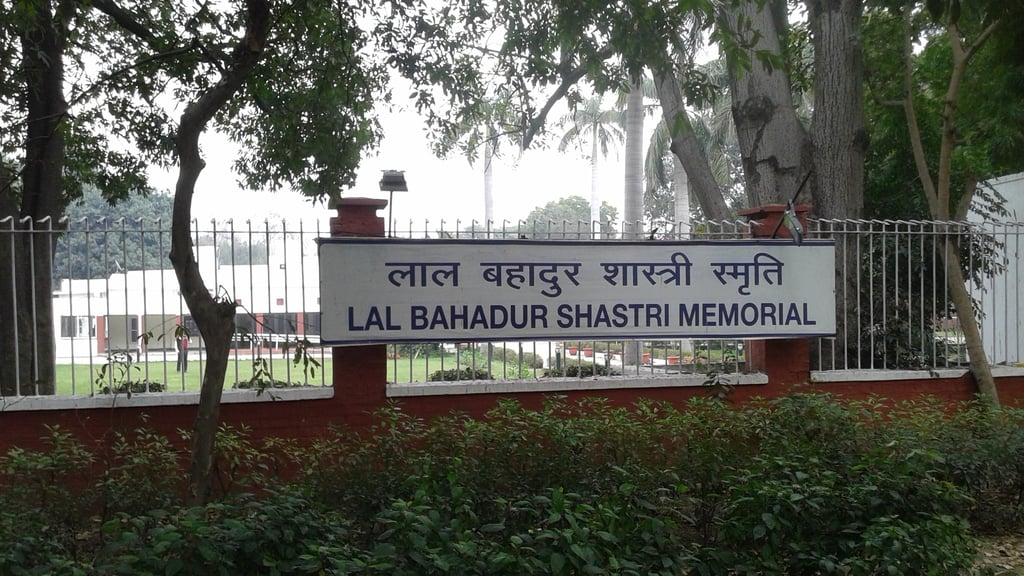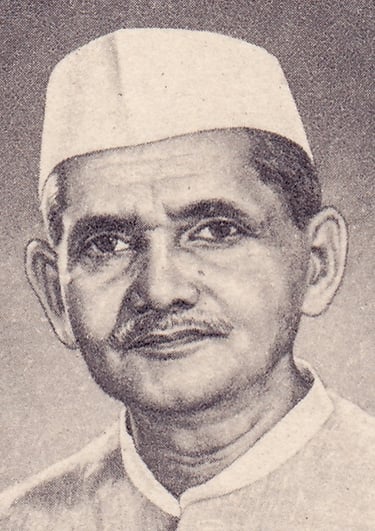
Lal Bahadur Shastri: The Forgotten Architect of Modern India
Discover the extraordinary leadership of India's second Prime Minister, Lal Bahadur Shastri, whose brief but transformative tenure shaped the nation's agricultural revolution, foreign policy, and governance ethics. This comprehensive profile explores how his humble origins informed his visionary leadership during critical national crises and why his legacy of integrity and strategic thinking remains relevant in contemporary India.
INDIAN HISTORYTHE GREAT LEADERPOLITICAL JOURNEYBIOGRAPHY/HISTORY
Keshav Jha
5/6/202512 min read


India's second Prime Minister, Lal Bahadur Shastri, embodied the essence of humility, integrity, and unwavering dedication to public service. Often overshadowed by his predecessor, Jawaharlal Nehru, and successor, Indira Gandhi, Shastri's brief yet impactful tenure as Prime Minister shaped modern India's trajectory. His leadership during challenging times—border conflicts with neighboring countries and severe food shortages—demonstrated exceptional crisis management skills and strategic vision. This diminutive statesman with extraordinary conviction left an indelible mark on India's political landscape, economic policies, and international relations.
Early Life and Formative Years
Born on October 2, 1904, in Mughalsarai, United Provinces (now Uttar Pradesh), Lal Bahadur Shastri entered the world in humble circumstances. The coincidence of sharing a birthday with Mahatma Gandhi seemed almost prophetic, as Shastri would later embrace Gandhi's philosophy of simplicity and non-violence.
Tragedy struck early when his father, Sharada Prasad Shrivastava, a schoolteacher, passed away when Shastri was merely eighteen months old. His mother, Ramdulari Devi, raised him along with his two sisters in the household of his maternal grandfather.
Despite financial constraints, Shastri's determination to pursue education never wavered. He walked barefoot to school daily, crossing the Ganges River by swimming when boats were unavailable—an early display of his resilience. His academic journey eventually led him to Kashi Vidyapeeth in Varanasi, where he graduated with distinction and earned the title "Shastri" (scholar), which replaced his birth surname.
During these formative years, Shastri developed a profound interest in philosophical texts and nationalist literature. He was particularly influenced by Annie Besant's works and the revolutionary ideas of Lokmanya Tilak. These intellectual pursuits laid the groundwork for his later political consciousness and commitment to social justice.
Entry into the Freedom Movement
Inspired by Mahatma Gandhi's call for non-cooperation, Shastri abandoned his studies in 1921 to join India's independence movement. His commitment to Gandhi's principles of non-violence and civil disobedience led to multiple imprisonments during the freedom struggle. Shastri was first imprisoned in 1921 during the Non-Cooperation Movement and subsequently in 1930 for participating in the Salt Satyagraha and again in 1942 during the Quit India Movement. These years in prison became his crucible, strengthening his resolve and deepening his understanding of political strategy.
Throughout this period, Shastri worked extensively at the grassroots level, organizing communities and advocating for social reforms. His work with the Servants of the People Society, founded by Lala Lajpat Rai, further honed his leadership skills and connected him with the struggles of ordinary Indians.
Shastri displayed remarkable courage during the freedom movement. In one notable instance, he led a procession against British rule in Allahabad despite prohibitory orders, risking severe punishment. His consistent willingness to face hardship and imprisonment earned him respect among fellow freedom fighters and the general public alike.
During his imprisonment at Almora Jail in 1932, Shastri devoted himself to studying the works of western philosophers and Indian scriptures, developing a syncretic worldview that would later inform his governance approach. His prison diaries reveal a contemplative mind grappling with questions of justice, governance, and the moral foundations of leadership.


Marriage and Personal Life
In 1928, Shastri married Lalita Devi, with whom he had six children—four sons and two daughters. Their marriage exemplified the values of simplicity and mutual respect that Shastri advocated in public life. Lalita Devi supported her husband's political activities despite the financial hardships and frequent separations that came with his involvement in the independence movement.
The couple's modest lifestyle became legendary. Even as Prime Minister, Shastri lived in a simple home and maintained frugal habits. When his wife wanted to buy a saree costing slightly more than their budget allowed, Shastri suggested she borrow the additional amount rather than use any official privileges—an anecdote that captures his scrupulous separation of personal and public resources.
Shastri's relationship with his children was characterized by warmth and moral guidance rather than material indulgence. He encouraged them to participate in the freedom struggle and live by the same principles of honesty and service that guided his own life. His family remained largely outside the political limelight during his career, in stark contrast to many political dynasties that emerged in post-independence India.
Political Ascendancy
Following India's independence in 1947, Shastri's political career flourished under Prime Minister Nehru's mentorship. His administrative acumen and unimpeachable integrity earned him ministerial positions of increasing responsibility:
Minister of Police and Transport in Uttar Pradesh (1947-1951)
General Secretary of the All-India Congress Committee (1951-1952)
As Railway Minister, Shastri took moral responsibility and resigned following a train accident in Tamil Nadu—establishing a precedent of ministerial accountability rarely witnessed in Indian politics before or since. This gesture of responsibility significantly enhanced his reputation as a principled leader.
In his role as Home Minister, Shastri demonstrated exceptional crisis management skills during the 1962 Indo-China war. His calm handling of internal security matters and refugee issues showcased his administrative capabilities under pressure. He also implemented significant police reforms, emphasizing the need for a more citizen-friendly approach to law enforcement.
Shastri's rise through the political ranks was neither rapid nor flashy. Instead, it reflected his methodical approach to governance and his ability to build consensus among diverse stakeholders. By the time of Nehru's death, Shastri had established himself as a respected figure within the Congress party—someone known for his loyalty to democratic principles rather than to any particular faction.


Prime Ministership: The Crucible of Leadership
When Nehru passed away in May 1964, Shastri emerged as the consensus candidate to lead the nation. His appointment surprised many international observers who expected more prominent figures to succeed Nehru. However, party leaders recognized Shastri's unique combination of administrative experience, ethical leadership, and ability to forge consensus among diverse factions.
Shastri's 19-month tenure as Prime Minister (June 1964 to January 1966) coincided with some of independent India's most challenging times:
Food Security Crisis
India faced acute food shortages when Shastri took office. His innovative response included the "Green Revolution"—a comprehensive agricultural strategy that transformed India from a food-deficient nation to one approaching self-sufficiency. He encouraged scientists like M.S. Swaminathan to develop high-yielding crop varieties and promoted modern farming techniques.
Shastri established the National Dairy Development Board and supported the White Revolution led by Verghese Kurien, which eventually made India the world's largest milk producer. He also initiated irrigation projects and promoted the use of chemical fertilizers to boost agricultural productivity.
His famous slogan "Jai Jawan, Jai Kisan" (Hail the Soldier, Hail the Farmer) recognized the equal importance of national security and agricultural production for India's progress. This philosophy continues to resonate in Indian policy circles today.
During the severe drought of 1965-66, Shastri took the unprecedented step of skipping his own meals one day a week and urged citizens to do the same to conserve food resources. This personal example of sacrifice strengthened public morale during a difficult period and demonstrated his belief in leading by example rather than by decree.
The 1965 Indo-Pakistan War
When Pakistan launched Operation Gibraltar in Kashmir, Shastri responded with strategic firmness that surprised international observers. His decision to expand the conflict beyond Kashmir to the Punjab sector proved decisive in bringing about a ceasefire. Throughout the conflict, Shastri maintained his composure and demonstrated remarkable strategic thinking.
Despite pressure from military advisors, Shastri made the critical decision not to extend the war into Pakistani territory, showing restraint that earned international respect. His leadership during this crisis defied the expectations of those who had dismissed him as a weak successor to Nehru.
Following the war, Shastri traveled to Tashkent, USSR (now Uzbekistan), for peace negotiations with Pakistani President Ayub Khan. The resulting Tashkent Declaration, signed on January 10, 1966, restored pre-war positions and pledged peaceful resolution of disputes.
Economic Policies and Administrative Reforms
Shastri's economic vision blended pragmatism with socialist principles. He recognized the limitations of central planning and encouraged private enterprise in certain sectors while maintaining the public sector's role in strategic industries. His approach to economic management was characterized by fiscal discipline and a focus on self-reliance.
To address corruption in public administration, Shastri established the Central Vigilance Commission in 1964. He also implemented administrative reforms to streamline decision-making processes and improve governance efficiency. His emphasis on administrative integrity stemmed from his conviction that governmental corruption undermined not just economic progress but public faith in democratic institutions.
Shastri also initiated measures to reform India's banking sector, laying the groundwork for the later nationalization of banks. He believed that financial institutions should serve broader development goals rather than merely commercial interests. This philosophy influenced India's economic policies for decades after his tenure.
Foreign Policy Initiatives
Shastri continued Nehru's non-alignment policy but added his own pragmatic approach to international relations. He strengthened ties with the Soviet Union while maintaining cordial relations with Western countries. His diplomatic efforts during the 1965 war demonstrated his skill in navigating Cold War politics.
Shastri cultivated stronger relations with neighboring countries like Nepal, Ceylon (now Sri Lanka), and Burma (now Myanmar). He viewed regional cooperation as essential for stability and development in South Asia. His approach to foreign policy was characterized by firmness in defending national interests combined with a genuine desire for peaceful coexistence.
During his brief tenure, Shastri also initiated outreach to African nations, recognizing their importance in the emerging post-colonial world order. He saw natural alliances between India and newly independent African countries facing similar development challenges and historical experiences of colonialism.
Personal Philosophy and Leadership Style
Shastri's leadership style reflected his personal values of simplicity, integrity, and pragmatism. Unlike many politicians of his era and since, he remained untouched by accusations of corruption or misuse of power. His personal modesty was legendary—when his family wanted to purchase a car, he insisted they first obtain a loan from a bank rather than using his position for special treatment.
His oratory lacked Nehru's eloquence, but his authentic communication resonated deeply with ordinary Indians. Shastri spoke plainly yet powerfully, connecting government policies to people's daily concerns. His emphasis on personal sacrifice during difficult times—encouraging citizens to skip one meal weekly during the food crisis—exemplified leadership by example.
Shastri's approach to conflict resolution, both internal and external, emphasized dialogue and mutual respect. He managed to balance firmness with flexibility, standing strong on principles while remaining open to reasonable compromise. This approach proved particularly effective in defusing regional tensions and addressing demands from various states within India.
Despite his gentle demeanor, Shastri possessed remarkable inner strength and moral courage. When faced with difficult decisions during the 1965 war, he displayed the resolve necessary to protect national interests. His principled leadership earned him respect across party lines and among international leaders.


Mysterious Death and Legacy
Tragedy struck hours after signing the Tashkent Declaration when Shastri died suddenly on January 11, 1966. Official reports attributed his death to a heart attack, but numerous conspiracy theories emerged, with some suggesting foul play. The lack of an autopsy and certain unexplained circumstances surrounding his death continue to fuel speculation decades later.
According to his personal physician, Dr. R.N. Chugh, Shastri had no history of heart disease. His sudden demise without a postmortem examination raised questions that persist to this day. His family members have consistently demanded a thorough investigation into the circumstances of his death, pointing to unusual marks on his body and the mysterious disappearance of his personal diary from Tashkent.
Shastri's legacy extends far beyond his brief tenure as Prime Minister:
Administrative Reform: His emphasis on ethical governance and accountability established important precedents.
Agricultural Innovation: The foundations he laid for agricultural modernization eventually enabled India's food self-sufficiency.
Foreign Policy: His balanced approach to Cold War politics maintained India's non-alignment while pragmatically engaging with both superpowers.
Leadership Model: His governance approach proved that humility and strength could coexist in effective leadership.
National Integration: His promotion of Hindi with the assurance that other languages would be protected helped navigate linguistic tensions.
Institutional Tributes and Memorials
Several institutions and memorials honor Shastri's contributions to Indian public life:
Lal Bahadur Shastri National Academy of Administration in Mussoorie, which trains India's civil servants
Lal Bahadur Shastri Institute of Management in Delhi
Lal Bahadur Shastri Memorial in Vijay Ghat, Delhi
Lal Bahadur Shastri National Award for Excellence in Public Administration
Lal Bahadur Shastri International Airport in Varanasi
In 2011, the Reserve Bank of India issued a commemorative coin featuring Shastri to mark his birth anniversary. Various educational institutions, roads, and public facilities across India bear his name, keeping his memory alive in the national consciousness.
Cultural Representations
Shastri's life has inspired various cultural works:
The 2019 biographical film "The Tashkent Files" explored conspiracy theories surrounding his death
"Lal Bahadur Shastri: Lessons in Leadership" by Pavan Choudary analyzed his governance approach
"Lal Bahadur Shastri: The Man of the Masses" by Sandeep Shastri offered a comprehensive biography
Several documentaries have chronicled his rise from humble origins to national leadership
These cultural representations have helped introduce Shastri's story to younger generations who might otherwise know little about this significant historical figure.
Socio-Economic Vision
Shastri's socio-economic vision was ahead of its time in many respects. He understood the importance of technological advancement in agriculture while recognizing the need to protect small farmers. His support for cooperative farming and dairy development reflected his commitment to balancing modernization with social equity.
His approach to economic development emphasized
Self-reliance without isolation from the global economy
Technological advancement with equitable distribution of benefits
Industrial development alongside agricultural prosperity
Public sector leadership with room for private initiative
Resource conservation alongside production growth
This balanced perspective on development laid important groundwork for India's subsequent economic evolution. His emphasis on agricultural self-sufficiency proved particularly prescient given the global food crises that followed in the 1970s.
Linguistic Policy and National Unity
Shastri navigated the complex linguistic politics of 1960s India with remarkable sensitivity. While he promoted Hindi as a national language, he assured southern states that their languages would receive equal respect and protection. This approach defused potential conflicts and contributed to maintaining India's unity amid linguistic diversity.
His policy of allowing state-level autonomy in linguistic matters while fostering an overarching national identity helped establish a workable framework for India's multilingual democracy. This approach recognized that cultural diversity could be a source of strength rather than division when properly managed.
Environmental Foresight
Although not typically remembered for environmental policy, Shastri showed remarkable foresight regarding natural resource management. He emphasized water conservation, soil health, and sustainable farming practices alongside increased production. His approach to the Green Revolution included concerns about soil depletion and water table management that would become mainstream environmental issues decades later.
Shastri supported afforestation programs and river conservation efforts at a time when environmental concerns were not yet prominent in political discourse. This aspect of his leadership reflected his holistic understanding of development as encompassing both material progress and environmental sustainability.
Remembering the Forgotten Prime Minister
Despite his significant contributions, Shastri remains somewhat overlooked in modern India's historical narrative. Several factors contribute to this relative obscurity:
His brief tenure compared to Nehru's 17 years and Indira Gandhi's 15 years
The absence of a powerful family dynasty to preserve his legacy
His unassuming personality that never sought personal glorification
The dramatic political events that followed his death, which diverted historical attention
In recent years, however, historians and political analysts have begun reexamining Shastri's leadership, recognizing its contemporary relevance. His emphasis on ethical governance, sustainability, self-reliance, and dignified international relations offers valuable lessons for modern challenges.


Contemporaries' Assessments
Those who worked with Shastri consistently noted his exceptional character and leadership qualities:
Former President Dr. S. Radhakrishnan described him as "a man of highest integrity" and "a national builder."
C. Subramaniam, who served as his Agriculture Minister, credited Shastri's visionary leadership for the success of the Green Revolution: "It was his political will that transformed our agricultural landscape."
Foreign leaders like Soviet Premier Alexei Kosygin and U.S. President Lyndon B. Johnson expressed admiration for his diplomatic skills and principled stand during international negotiations.
Even political opponents acknowledged his personal integrity and commitment to democratic values. Socialist leader Ram Manohar Lohia, a fierce critic of Congress policies, remarked that "Shastri represents the best tradition of Indian leadership."
Relevance in Contemporary India
Shastri's governance model offers valuable insights for addressing current challenges:
His emphasis on administrative accountability provides a blueprint for tackling corruption.
His balanced approach to development, combining technological advancement with social justice, offers guidance for inclusive growth.
His method of crisis communication, combining honesty about challenges with confidence in solutions, demonstrates effective leadership during difficult times.
His integration of agricultural productivity with national security thinking remains relevant in an era of climate change and food security concerns.
His ability to build consensus among diverse stakeholders offers lessons for managing India's pluralistic democracy.
As India navigates complex 21st-century challenges, Shastri's approach—combining ethical governance, strategic thinking, and inclusive development—provides an enduring model of effective leadership.
Lal Bahadur Shastri's journey from a small village to India's highest office embodies the democratic promise that merit and integrity can triumph over privilege and pedigree. His leadership during the crisis demonstrated that quiet strength often proves more effective than dramatic gestures.
As India continues its ascent on the global stage, Shastri's legacy reminds us that sustainable progress requires balancing military security with agricultural productivity, technological advancement with ethical governance, and international engagement with self-reliance. His life teaches that true leadership is measured not by longevity in office but by impact through action and example.
In Shastri's own words, "There comes a time in the life of every nation when it stands at the crossroads of history and must choose which way to go." His choices during India's crossroads moments continue to influence the nation's journey decades after his passing.
The diminutive man with extraordinary conviction may have occupied the prime minister's office briefly, but his impact on India's identity and development path has been profound and enduring. In an era of political personality cults and dynastic succession, Shastri's legacy stands as a testament to the power of principled leadership and simple integrity.
Subscribe To Our Newsletter
All © Copyright reserved by Accessible-Learning Hub
| Terms & Conditions
Knowledge is power. Learn with Us. 📚


